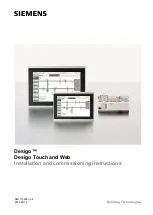
Ver. 2.0U Dec. 4, 2008
- 3 - Installation Manual for PV modules
typically face south, and in the southern hemisphere, PV modules
should typically face north.
Please make sure that there are no obstructions in the surroundings of
the site of installation. Take proper steps in order to maintain reliability
and safety in case the PV modules are installed in areas that have
heavy snow / extreme cold / strong winds / installations over, or near,
water and areas where installations are prone to salt water exposure or
on small islands or in desert areas. If you are planning to use the PV
modules where salt water damage may occur, please consult with
SHARP to determine an appropriate installation method, or if
installation is possible.
A-5. TILT ANGLE SELECTION
The tilt angle of the PV module is measured between the surface of the
PV module and a horizontal ground surface. The PV module generates
maximum output power when it faces the sun directly.
For standalone systems with batteries where the PV modules are
attached to a permanent structure, the tilt angle of the PV modules
should be selected to optimize the performance based on seasonal
load and sunlight. In general, if the PV output is adequate when
irradiance is low (e.g., winter), then the angle chosen should be
adequate during the rest of the year. For grid-connected installations
where the PV modules are attached to a permanent structure, PV
modules should be tilted so that the energy production from the PV
modules will be maximized on an annual basis.
A-6. ELECTRICAL INSTALLATION
To ensure proper system operation and maintain the warranty, be
careful to observe the correct cable connection polarity (Figure 1) when
connecting the modules to a battery or to other modules. If not
connected correctly, the bypass diode(s) could be destroyed. All PV
modules must be grounded by electrical connection of the module
frames to ground. Care must be taken to arrange the system ground so
that the removal of one module from the circuit will not interrupt the
grounding of any of the other modules. For grounding, each PV module
has a hole in the frame for either a bolt, nut and washer, a ground lug
fastened by bolt or screw, or an appropriate screw (hardware not
provided). Installation for wiring shall be in accordance with the NEC
and grounding method shall comply with the NEC, article 250 and the
relevant instructions below. In a connection of this type, the hardware
(such as a star washer) must score the frame surface to make positive
electrical contact with the frame. The ground wire must not be smaller
than No.14 AWG (2.1 mm
2
), and should be sized according to the
NEC.
Hardware used must be compatible with the mounting structure
material to avoid galvanic corrosion. If using the SHARP On-Energy
mounting system, the module and mounting structure may utilize an
“integrated grounding” system in which individual wire grounding of
every module is not required. Refer to the OnEnergy System
Installation Manual.
If modules are installed in a readily accessible location (per NEC)
where the circuit is operating in excess of 30 volts, nominal, maximum
system voltage for DC or 30 volts for AC circuits, NEC requires
installing the additional locking sleeve connector (Multi Contact
#PV-SSH4) on the connector. Note that this sleeve is not included with
the module. See Figure 2.
Grounding Using Existing Ground Hole (Figure 3)
The existing ground holes can be used with stainless steel #10-32
bolts, #10 lock washers and #10-32 nuts. All grounding hardware must
have a thread count of at least 32 turns per inch. These holes may be
used to secure an outdoor-rated, tinned copper, UL listed lay in ground
lug such as Ilsco model GBL4-DBT or equivalent.
Grounding Using Existing Unused Module Mounting Hole
(Figure 4)
An existing otherwise unused module mounting hole can be used to
install the same grounding hardware noted above. Do not use a
mounting hole or hardware that is used for structurally mounting the
module. UL 1703 prohibits the use of a bonding fastener for any
purpose other than ground bonding.
A-7. MAINTENANCE
SHARP PV modules are designed for long life and require very little
maintenance. If the angle of the PV module is 5 degrees or more,
normal rainfall is usually sufficient to keep the module glass surface
clean under most weather conditions. If dirt build-up becomes
excessive, clean the glass surface only with a soft cloth using water. If
cleaning the back of the module is required, take utmost care not to
damage the back side materials. In order to ensure proper operation of
the system, please check all wiring connections and the condition of
the wire insulation periodically.
SERIES WIRING (VOLTAGE ADDITIVE)
PARALLEL WIRING (CURRENT ADDITIVE)
Additional locking sleeve
Figure 2
Figure 1
Lay in Ground Lug
Figure 3
Figure 4
SERIES WIRING (VOLTAGE ADDITIVE)
PARALLEL WIRING (CURRENT ADDITIVE)
Additional locking sleeve
Figure 2
Figure 1
Lay in Ground Lug
Figure 3
Figure 4


























